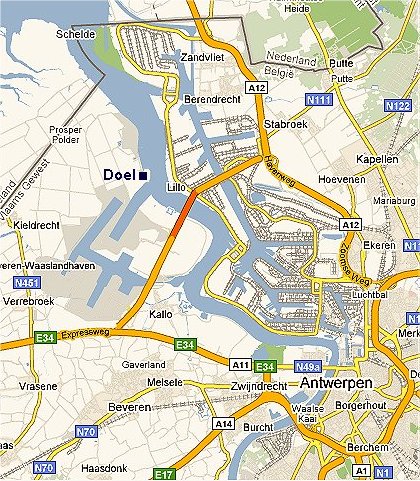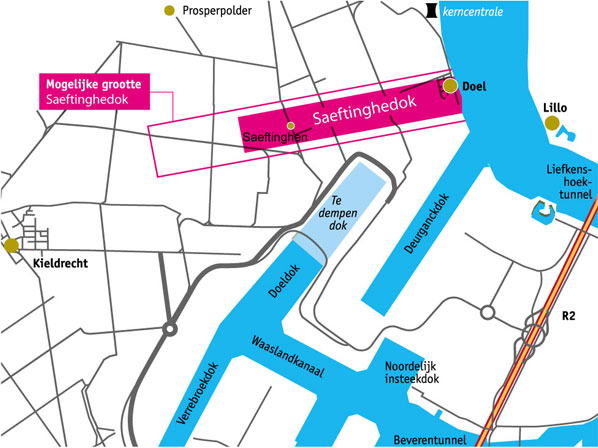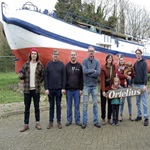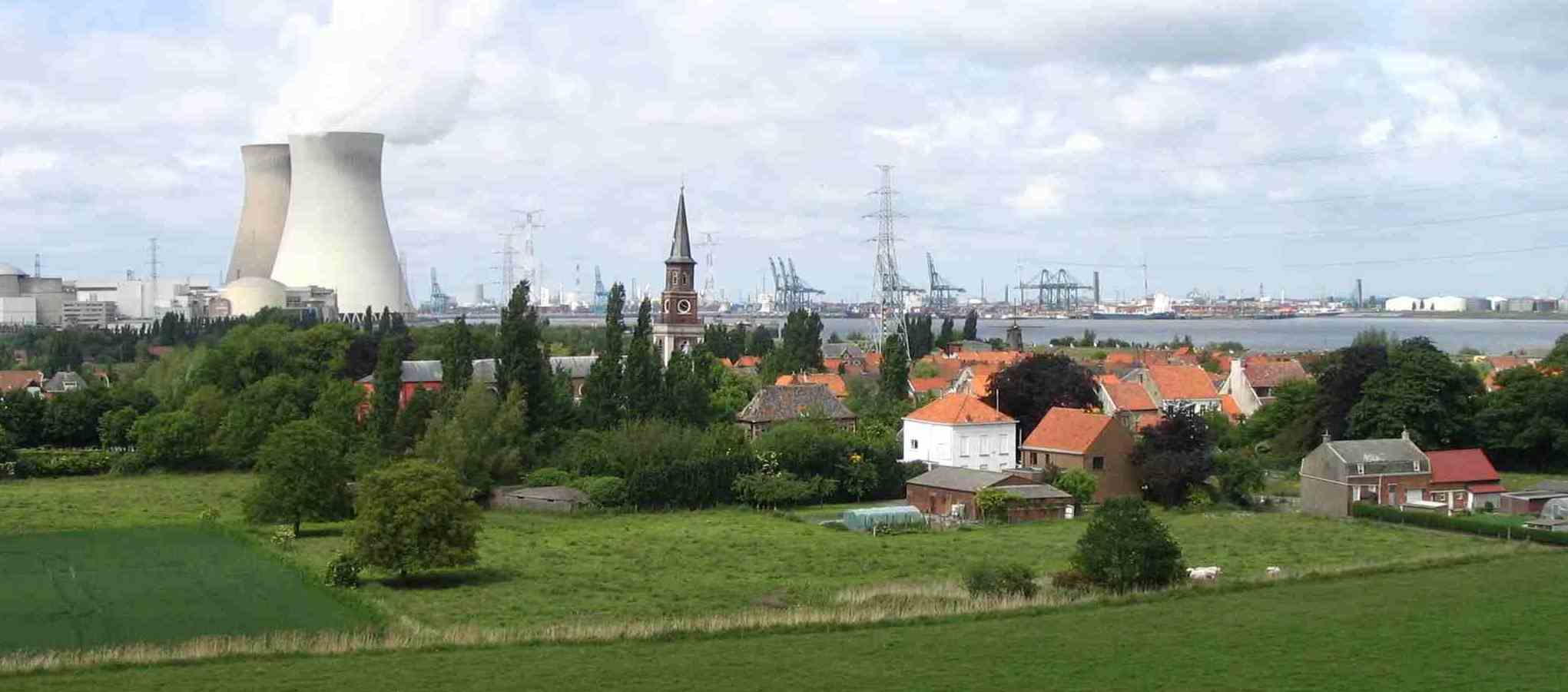 |
 BOEK: Doel2020. Het gevecht om Doel en de polder (door Jan Creve) BOEK: Doel2020. Het gevecht om Doel en de polder (door Jan Creve)€ 24,- overschrijving op rek. nr. BE 26 4186 0588 9129 van Doel2020, vermelding van je adres en "Bestelling boek Doel 2020" |
Information in EnglishDoel, The Village That Does Not Want to Disappear
Doel is a small, 700-year old village in the Belgian polder on the left bank of the river Scheldt. It is located at a ferry boat trip's distance from the city/port of Antwerp. Although Doel is only a very small village, its skyline is well known throughout Belgium and the Netherlands because it hosts a nuclear power plant with two giant cooling towers. 
By the early sixties, the ever expanding port of Antwerp had outgrown available docklands on the Scheldt's right bank and the Antwerp Port Authority started to build an extensive network of docks, interconnecting channels, and locks at the left bank, to the south of Doel. In the early 1970s, the Port Authority ignored farmers' and villagers' protests and started to expropriate houses in several polder villages, hereby sacrificing local rural communities to industrial and economic interests. Because of the port's northbound expansion plans, which also threatened Doel, the authorities proclaimed a "house building freeze", obliging young married couples to leave the village and settle elsewhere for lack of available housing. As a result, the village began to decline. Successful actions by protest groups and local politicians in the late seventies, however, managed to temporarily put a halt to the Port Authority's voracious northbound expansion plans and Doel experienced well over a decade of renewed hope and revival. Thanks to the ferry service, the cosy polder village even became a flourishing tourist attraction. Yet, its survival dreams were relatively short-lived. As of the mid-nineties, plans for a new dock and two container terminals again tightened the industrial noose around the community's neck. In 1998/99, the Flemish regional government signed the village's death verdict by approving the construction of two new container terminals. The first, Deurganck dock, has been operational since 2005. It is located just south of Doel. According to initial plans, the second terminal (Saeftinghe) was to be built a few years later. If ever it materializes, it will wipe Doel off the map. This utterly gloomy prospect led many disillusioned villagers to "voluntarily" sell their houses to a semi-public expropriations company. Although the government promised to keep the village intact until 2007, this company refused to temporarily rent vacant houses to candidate dwellers, preferring instead to let the properties go to ruin. This premeditated process of neglect undermined the village's chances of survival and caused the number of inhabitants to drop from 900 to 300-400. By the end of 2005, however, the plans for the second container terminal that would definitively wipe Doel off the map were shelved for an indefinite period. This sparked renewed hopes that the expansion of the port may stop at the village's southern border. Since 2005, young though mostly responsible squatters have come to the village and settled in deserted houses, in defiance of the expropriations company's rental stop. They restored some houses to a habitable status. By now, many of these "newcomers" have positively contributed to the village's viability and social life. Following media reports in 2006 on social tensions, abuses of utilities, and health hazards, the local district authorities decided to regularize the situation of all well-intentioned squatters, to oust troublemakers and to demolish dilapidated houses. Because of these developments, there was again a glimmer of hope...but on 23 March 2007, the Flemish Government decided that Doel will be demolished anyway as of 2009, even if the Saeftinghe terminal never materializes... 
In June 2008, inhabitants received an official letter notifying them their houses should be evacuated by 1 September 2009. Doel 2020 is the inhabitants organisation of the Belgian village of Doel
|
 |
Doel vierde 25 jaar gemeenschapshuis De Doolen 1 oktober 2025 |
 |
Extra-Containercapaciteit aan herziening toe door plannen Katoen Natie 30 september 2025 |
 |
Scheldewijding en Doelse feesten 17 augustus 2025 |
 |
Nieuwsbrief van 5 augustus 2025 5 augustus 2025 |
 |
D2020 waarschuwt voor losse eindjes bij project mobiliteit Waaslandhaven 5 augustus 2025 |
 |
Doel 2020 wil maatregelen tegen vandalisme in Doel 30 juli 2025 |
 |
D2020 en EGPD vragen aandacht voor habitats op erfgoedsites 26 april 2025 |
 |
Gemeentebestuur moet inzage geven in mailverkeer technofestival 8 april 2025 |
 |
Overlijden medestander Paul Staes 13 november 2024 |
 |
Opnieuw hommeles rond technofestival in Doel 31 augustus 2024 |
 |
48ste Doelse Feesten en Scheldewijding 18 augustus 2024 |
 |
Nieuwsbrief van 13 augustus 2024 13 augustus 2024 |
 |
Overlijden Guido Van de Walle 28 juni 2024 |
 |
Nieuwsbrief van 28 juni 2024 28 juni 2024 |
 |
Restauratiewerken Ortelius in Doel deze week van start 14 maart 2024 |
 |
Historisch kerkhof Doel krijgt opwaardering 1 februari 2024 |
 |
Onroerenderfgoedrichtplan Doel en polders 9 oktober 2023 |
 |
Doelse Feesten en Scheldewijding 2023 27 augustus 2023 |
 |
47e Scheldewijding en Doelse Feesten: Doel mee maken 23 augustus 2023 |
 |
Nieuwsbrief van 6 augustus 2023 6 augustus 2023 |
 |
ANB herziet plannen ivm kap van bosgebied in Verrebroek 14 juli 2023 |
 |
Kap van bosgebied in Verrebroek is onaanvaardbaar 7 juli 2023 |
 |
Maurice Vergauwen overleden 20 mei 2023 |
 |
D2020 tevreden met tijdelijke oplossing molen Doel 10 mei 2023 |
 |
Verbond voor de Toekomst. 1 jaar verder. 30 maart 2023 |
 |
Dreigende instorting maalderij Doel toont waar noden liggen 8 maart 2023 |
 |
Nieuwsbrief van 8 maart 2023 8 maart 2023 |
 |
Provincie wijst plannen Molen af. Doel 2020 wil realistische oplossing 1 maart 2023 |
 |
Nieuwe website KoesterDoel.be 26 februari 2023 |
 |
Technofestival Doel had g��n rechtsgeldige vergunning 26 oktober 2022 |
 |
Bordjes begraafplaats Doel zorgen voor paniek nabestaanden 24 oktober 2022 |
 |
Zogenaamd Doelfestival geen meerwaarde voor een uniek dorp als Doel 19 september 2022 |
 |
Rechtbank wijst vordering van Doelenaars af 1 september 2022 |
 |
Scheldewijding en Doelse Feesten 21 augustus 2022 |
 |
46e Scheldewijding in Doel op zondag 21 augustus in geest van optimisme 10 augustus 2022 |
 |
Beveren zet zichzelf klem met afgekeurd plan molen Doel 16 juli 2022 |
 |
Nieuwsbrief van 4 juli 2022 4 juli 2022 |
 |
Plannen voor technofestival in Doel komen voor de rechtbank 20 juni 2022 |
 |
Kan technofestival in Doel nog doorgaan? 12 juni 2022 |
 |
Bewoners en verenigingen willen geen dancefestival in historisch centrum van Doel 31 maart 2022 |
 |
Doel 2020 en het Verbond voor de Toekomst 30 maart 2022 |
 |
Nieuwsbrief van 30 december 2021 30 december 2021 |
 |
Toekomst Doel krijgt vorm met aanplant voedselbos 18 december 2021 |
 |
Doel op shortlist van The 7 Most Endangered Programme 2022 15 december 2021 |
 |
Historisch schip Ortelius ommekeer voor Doel 20 november 2021 |
 |
Grootste Nederlandse erfgoedvereniging draagt Doel voor als meest bedreigd erfgoed Europa 15 november 2021 |
 |
Bezwaren bij restauratieproject Hof ter Walle 23 september 2021 |
 |
Doel 2020 opgetogen met beslissing bufferdijk 8 september 2021 |
 |
Nooddecreet voor nieuw dok op Linkeroever? 10 juni 2021 |
 |
EGD&P in beroep in tegen sloop. Gemeente erkent argumenten 28 mei 2021 |
 |
Werkgroep Doel opgeschort. Vlaamse Regering start nieuwe onderhandelingen op. 28 mei 2021 |
 |
Gemeente wil behoud Ouden Doel en vergeet andere gehuchten 16 mei 2021 |
 |
Nieuwsbrief van 30 april 2021 30 april 2021 |
 |
ECA-problemen blijven: wantrouwen en te weinig garanties leefbaarheid 28 april 2021 |
 |
D2020 tevreden met maatregelen overlast en blijft aandringen op gemaakte afspraken Vlaamse Regering 27 april 2021 |
 |
Doel 2020 blijft afwachtend na doorstart toekomststudie Doel 21 maart 2021 |
 |
Historisch schip Ortelius komt naar Doel. 3 maart 2021 |
 |
Toekomststudie Doel heropgestart, controverse blijft. 9 februari 2021 |
 |
Vlaamse Regering moet einde maken aan obstructie Havenbestuur 27 januari 2021 |
 |
Doel 2020 opgetogen met beslissing renovatie kaaimuur haven Doel 5 december 2020 |
 |
Complex Project ECA gaat deels in op bezwaren actiecomit�s 2 december 2020 |
 |
Fakkeltocht afgelast 7 november 2020 |
 |
Kaaimuur Doel wordt nu toch hersteld 13 oktober 2020 |
 |
Doel, een (blijvende) schande voor Vlaanderen 17 september 2020 |
 |
Havenuitbreiding Linkerscheldeoever zit op dood spoor 27 juli 2020 |
 |
Nieuwsbrief van 7 juli 2020 7 juli 2020 |
 |
Strafmaatregelen van Vlaamse Regering voor Doel en de polderdorpen 14 juni 2020 |
 |
Rechtsgang Raad van State tegen ECA was/is onvermijdelijk 27 mei 2020 |
 |
Mobiliteitsplannen zonder betrekking polderdorpen slag in het water 8 mei 2020 |
 |
Historisch schoolschip Ortelius gaat naar Doel 22 april 2020 |
 |
Historisch kerkhof van Doel wordt behouden! 8 april 2020 |
 |
Reportage Gehavend van Martijn Veerman 27 februari 2020 |
 |
500 bomen weg in ruil voor buffering polderdorpen? 22 februari 2020 |
 |
Nieuwsbrief van 7 januari 2020 7 januari 2020 |
 |
Regering bevestigt havenuitbreiding maar problemen niet van de baan 20 december 2019 |
 |
Fakkeltocht Doel bracht 800 mensen op de been 11 november 2019 |
 |
6e Fakkeltocht voor Doel en Polder 10 november 2019 |
 |
Geen veer, wel pleziervaarten op gevaarlijke Schelde 14 oktober 2019 |
 |
Voor de 15de maal brand gesticht in Doel 30 september 2019 |
 |
Vertoning documentaire Doel 29 september 2019 |
 |
Breng de waterbus naar Doel 21 september 2019 |
 |
De lusten voor de Haven, de lasten voor de gemeenschap. 16 september 2019 |
 |
Tentoonstelling dorpstekenaar Jeroen Janssen, Belvue-museum, Brussel 13 september 2019 |
 |
VLM wil beslagname bij woordvoerder Doel 2020 26 augustus 2019 |
 |
Programma 45e Doelse Feesten en Scheldewijding 11 augustus 2019 |
 |
45e Scheldewijding en Doelse Feesten op zondag 11 augustus in het dorp dat niet weg wil. 6 augustus 2019 |
 |
Nieuwsbrief van 5 augustus 2019 5 augustus 2019 |
 |
Opnieuw veerdienst Doel-Lillo tijdens Scheldewijding Doel 18 juli 2019 |
 |
Erelijst Eerste DoolenPo�zieLawinePrijs 13 juli 2019 |
 |
Voorlo(H)opige, F(H)inale, (H)Artistieke (H)Afsluitsessie 6 juli 2019 |
 |
Ruime opkomst voor boek over geschiedenis van Doel 2020 17 juni 2019 |
 |
Nieuwsbrief van 12 juni 2019 12 juni 2019 |
 |
Dichter-wandeling & Fototentoonstelling 1 juni 2019 |
 |
Doel blijft en dat is definitief 17 mei 2019 |
 |
Gemeente wil geen overleg met Doel 2020 en Doelland 9 mei 2019 |
 |
DoelDorpsDichter nodigt uit: Maarten Ingels 4 mei 2019 |
 |
Fiets op erfgoeddag langs evenementen en poldermonumenten 27 april 2019 |
 |
DoelDorpsDichter nodigt uit: Nelly Maes 6 april 2019 |
 |
Project Groot-Saeftinghe moet rekening houden met nieuwe realiteit en bewoners 15 maart 2019 |
 |
Schepen en MLSO-voorzitter Boudewijn Vlegels tegen plan Weyts? 22 januari 2019 |


